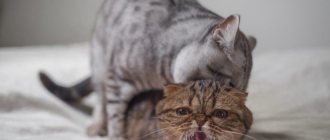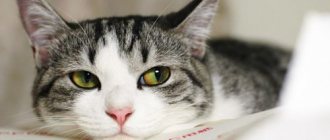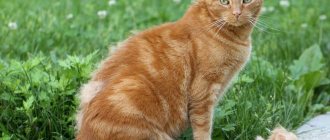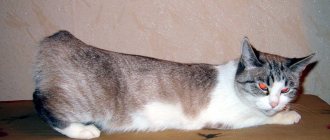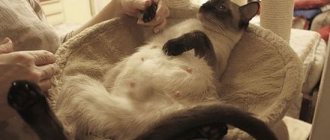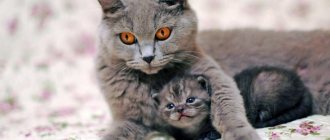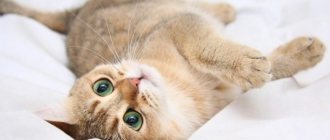For every cat owner, a source of pride is its shiny and beautiful coat. As soon as the cat begins to actively lose its fur, spreading its fur throughout the apartment, especially when the cat's shedding is prolonged, the owners begin to worry. And the cause of concern is not only frequent wet cleaning in the apartment due to the large amount of cat hair, but also whether your pet is sick.
Is shedding normal in a cat or is it one of the symptoms of some disease?
Seasonal shedding. Molting is inherent in all living beings. A cat living in a city apartment is no exception. In the spring, cats change their “coat” in accordance with the growing warmth in nature, and in the fall, with the approach of cold weather, that is, the cat’s owners observe the process of losing and growing new hair. During shedding, the cat behaves as usual, its appetite is preserved, and it does not outwardly look sick. When a cat sheds, it leaves behind a large amount of fur. To keep your pet's coat smooth and fluffy during shedding, try to choose the highest quality premium food. Brush your cat regularly using special brushes and combs. In cats living in city apartments, shedding can last from 2 to 3 months.
Apartment molt . Cats living in an apartment shed all year round, despite good nutrition, absolute health and quality care. Such cats practically do not feel the change of seasons: the molting period in indoor cats stretches for several months, or even the whole year. Indoor shedding intensifies in winter, when the heating starts working in the house or apartment, and the drier the air in the room, the stronger the cat’s shedding. Air conditioners, air humidifiers, and even simple aquariums can partially help owners cope with indoor shedding. For such a cat, owners need to choose suitable food and professional hygiene products (shampoo, conditioner, nourishing masks). Anti-shedding vitamins for cats are effective, but they should not be abused - a maximum of two monthly courses per year.
Baby shedding is the process of changing a kitten's fur to adult fur. Kittens begin to shed at 6 months of age. Molting in kittens continues for 1-2 months. Coarser adult hair grows back, which is thicker and heavier than baby fur. At the same time, the patterned kittens become brighter - the ghostly haze disappears, and the slight fading of the fur, necessary for camouflaging the young, disappears. The dark areas of the skin of Siamese and Burmese become brighter and richer. During a child's coat change, no remedy for shedding cats will help; the owner can only comb the coat daily and make sure that the baby is fed well. The better the living conditions, the faster the coat will change and the more beautiful the adult coat will be.
Pregnancy and feeding kittens . Loss of a significant amount of hair, up to partial baldness, can also be noted in pregnant cats because... During pregnancy, a profound restructuring of metabolism occurs in a cat’s body, and the cat primarily spends the nutrients supplied with food on building the body of the kittens and on their subsequent feeding. After a cat stops feeding her offspring, her coat returns to normal and looks like before pregnancy.
Old age of the cat. Owners often notice thinning fur in older cats around the ears and face. This hair loss does not require special drug treatment; you will need to consult a specialist about feeding an aging cat.
Stressful situations - all animals, including cats, can worry and experience severe nervous overexcitation, which ultimately negatively affects their health, as well as the quality of their coat. A trip to the country, a change of place of residence, the arrival of a new tenant, a fight with its relatives during a walk, meeting a dog, quarrels between family members can become reasons for a cat’s distress. If your pet sheds because of this, then it is important to create a calm atmosphere, surround it with attention and care, and provide sedatives.
Improper grooming is often the reason why a cat sheds all year round. In the case when the cat is clinically healthy, and the change in coat is not pronounced - it sheds little by little and all year round, it is necessary to pay attention to the composition of shampoos, the quality of brushes and other grooming tools. Owners should brush their cat at least once a week: gentle movements with the brush stimulate blood circulation, improving nutrition of the hair follicles and reducing shedding. Shampoos and conditioners must be chosen specifically for cats, and do not forget to dilute them as written on the packaging.
Why and how cats shed
Shedding in cats is a natural, regular process of changing coat. Shedding in animals happens for different reasons and at different times.
Shedding is a common occurrence in cats.
Seasonal
In a normal situation, a cat sheds twice a year:
- the beginning of cold weather. The transition to the winter season is signaled by a decrease in daylight hours, a decrease in temperature, and this turns on protective mechanisms in animals. Cats quickly grow new fur to keep them warmer in cold weather.
- onset of heat. In summer, the hair grows lighter so that it does not get hot.
Cats who roam freely react the most to the change of season. Their body senses weather changes more strongly and reacts more sensitively.
Pets that are not allowed outside also shed, but regardless of natural conditions. Shedding occurs once or twice a year.
Seasonal molting lasts about a couple of weeks to two months. If the shedding continues, you should contact your veterinarian.
According to breed characteristics
In cats with long, thick fur, this process occurs much more noticeably.
Mustaches are divided into 4 types:
- long-haired;
- semi-longhaired;
- short-haired;
- hairless.
The shorter the coat and thinner the undercoat, the less problems with shedding.
Features of the procedure
Shih Tzu puppy haircut: how to cut it at home
Express shedding is a forced procedure. She's quite delicate. Different breeds have different hair quality. Often the skin under a thick layer of fur is vulnerable and irritated. Considering these facts, it is better to carry out the express shedding procedure in a special dog grooming salon.
Express molt in the salon
To maintain their reputation and attract more clients, salon owners try to acquire a wide range of detergents (shampoos, conditioners, masks), tools, and auxiliary materials. All their care materials are usually certified.
Important! Our specialists have experience working with representatives of different breeds. In addition, they have knowledge in the field of veterinary medicine. In case of force majeure, they will be able to make the right decision.
The service can be described step by step as follows:
- To begin with, the animal is thoroughly combed. They sort out all the tangles. This step removes most of the dead hair.
- The wool is washed with a special shampoo (the right one is chosen for each breed).
- A special warming agent is driven or rubbed into the fur.
- Wrap in layers with cloth, film, cloth. To retain heat, the last layer should be thicker and denser.
- After 15-20 minutes, the product is washed off.
- Use a powerful professional hairdryer to dry the skin. This accessory has enough air force to remove weak hairs, pulling them out of the hair follicles.
Important! At each stage of the procedure, the coat should be brushed vigorously.
As a result of forced molting, the pet’s well-being improves, since it becomes less hot. He sweats less. It is more difficult for insect pests to hide in sparse, faded fur.
Almost all salons offer a range of services. At the same time, you can trim your claws, clean your ears and eyes. As a result, the overgrown dog will turn into a super-groomed one. You can also get professional advice on care, for example, purchasing care products and tools.
Experts recommend combining express shedding with seasonal shedding. Usually once a year is enough.
When do kittens start moulting?
Little kittens hardly shed; instead of fur they have baby fluff.
But caring for the fur of kittens should begin at a young age, as it will be much easier to accustom them to brushing.
However, caring for a kitten’s fur coat, and, in particular, brushing, must begin from an early age. It is much easier to train a small kitten to be groomed than an adult. Also, early brushing will help prepare them for their first shed.
It's easier to train a kitten to brush
Kittens begin to shed at about six months (5 – 8 months). Not only the fur changes, but also its color. When cats begin to shed for the first time, which can be up to 6 months, it is the most intense because the body is subject to a complex maturation process.
Causes of severe shedding
The normal state of health of an animal during molting is if:
- Skin of normal color.
- The wool does not fall out in clumps, leaving no bald spots.
- The cat has a normal appetite and a healthy appearance.
- There is no unpleasant odor from the mouth or ears.
- body temperature is normal.
Hair loss is almost never the only symptom of any disease.
But sometimes the shedding becomes very strong.
Apartment molt
This type of shedding is common in pets. It is especially aggravated during the heating season, when the air in the apartment becomes very dry. You can use a humidifier to avoid excessive hair loss.
Apartment shedding is stronger during the heating season
Hormones
Unneutered cats who are not sexually active may suffer from hormonal imbalances. This greatly affects the condition of the pet’s skin.
Hormones can fluctuate after estrus, during pregnancy and after childbirth, just like in humans.
If you do not breed cats, then it is better to have surgery. If this is not possible, your doctor may recommend a course to avoid hormonal imbalances.
Stress
Cats have a very good nervous system. But even they are susceptible to stress under certain conditions:
- Change of habitual habitat.
- A trip in public transport, a long road.
- The appearance of a new animal in the house.
- Long-term loneliness.
- Change of habitual way of life (usually lack of affection, new prohibitions, etc.)
Cats shed a lot due to stress
Try to save your cat from unnecessary worries and isolate him from unusual situations. If the shedding goes away, then the problem is definitely due to stress.
Improper care and feeding
Owners should take very good care of their beloved pets. Feeding and care are the main things we need to provide them with. Care products must be strictly individual and suitable for the cat’s breed (shampoos, brushes, ointments).
The diet must be balanced; you cannot feed cats food from the table. Good animal feed contains all the necessary microelements and substances.
Hair loss also occurs due to dysbiosis after treatment with antibiotics. Intestinal function is disrupted.
Old age
As cats age, their body begins to work worse, their immune system weakens, causing their fur to become thin, dull, and fall out. This is a natural life cycle.
Cats lose fur as they age
Allergy
An allergy is a skin reaction, namely inflammation, redness, itching. This ailment occurs as a result of a change in the usual diet.
Allergies are usually accompanied not just by hair loss, but by the formation of bald patches.
In case of allergies, hair falls out due to damage to the skin.
A possible allergen should be excluded and the process of hair loss should be monitored.
Diseases and parasites
Severe hair loss is caused by a number of diseases, both skin and internal. This is already a pathology.
Skin diseases:
- Ringworm, fungal infections.
- Demodicosis (subcutaneous mites);
- Dermatitis (due to flea secretions, ectoparasites).
- Scabies (Notoedris cati mite).
- Eczema.
In case of allergies, hair falls out due to damage to the skin.
All of these diseases are characterized by clear lesions and are accompanied by irritation and fur loss.
Internal diseases include endocrine system disorders, including diabetes mellitus or neoplasms. In these cases, baldness is a secondary symptom and the primary cause must be dealt with.
SEE THE STAGES OF KITTEN DEVELOPMENT IN THE KITTEN GROWTH TABLE
Let's consider all stages of development of kittens from birth to one year, their characteristics of maturation and growth, features of care at each age.
A newborn kitten is born weighing 80-120 grams, the size of kittens at birth is body length about 9-12 cm.
Very rarely, but still there are cases of the birth of kittens 50-70g, they are small but active. This does not always serve as a signal that the kitten is sick or has abnormalities. This also occurs in multiple pregnancies or in the case of small parents.
Newborn kittens: photo of the litter Newborn kittens are absolutely helpless during this period, they are blind, deaf, and do not know how to regulate their temperature. Newborn kittens have no undercoat; the fur is thin, weak and does not warm at all.
Newborn British kittens Kittens do not know how to stand on their paws, their bones are very fragile, so babies require special care. At this time, sleep and kittens are almost inseparable concepts. Newborn kittens sleep almost constantly and eat a lot and often. Kittens need sleep for the further development of their nervous system. Newborn kittens also cannot defecate on their own; the mother cat licks their genitals and eats their feces. What is really well developed in newborn kittens is their sense of smell and touch; they easily find their mother’s nipples, fingering them with their paws, sucking and, thereby, stimulating further milk production.
Newborn kittens: photo of the litter During this period, it is better not to touch the kittens at all, just monitor their weight. Kittens should add it daily (about 10-20 grams per day), if the kitten is growing, then everything is in order.
Things to take care of:
- Set up a box for a cat (or organize a maternity house) with newborn kittens. It should be warm and dry there. The bedding should be changed (it is advisable to use white sheets to track the color of the mother cat’s discharge), because The cat will have postpartum discharge. Also, if necessary, you can put a heating pad.
- Cat food. It should be plentiful and balanced; food is a must for nursing cats. Food and water should be freely available, next to the nest box. It is also recommended to place a tray here.
Cats are by nature excellent mothers and may not leave the box for a whole week, so it is important that newborn kittens have enough milk. In the first days, the cat produces colostrum (very fatty, nutritious milk that has antibodies, thanks to which kittens develop lasting immunity).
If there are a lot of kittens, be sure to make sure that each newborn kitten gets its good portion.
The development of kittens after birth (the development of newborn kittens) is very active, so the first week can be planned out day by day.
Ways to reduce shedding
It is impossible to get rid of natural shedding. Only serious illnesses require drastic interventions. And in normal times, we can only slightly reduce hair loss.
Vitamin complexes
Supplements reduce the amount of hair loss. Be sure to consult with your veterinarian about which vitamins are right for your pet.
Vitamins help against hair loss
Along with the supplements, you can give yolk (if you are not allergic) and sprouted grass.
Sprouted grass is useful in combination with vitamins
Buy a special paste for removing hairballs from the body of cats.
Special feed
A balanced diet is very important during such a period.
To ensure that the fur is always beautiful and healthy, and molting is not a severe torment, the animal’s food must contain: biotin (vitamin B7, deficiency leads to inflammation in the hair follicles. Acute biotin deficiency can lead to baldness) taurine, sulfur (enhances the effect of biotin ), vitamins B6, B2, B5, iodine, calcium, phosphorus, omega-3, omega-6.
Cat food is rich in essential nutrients
If the cat's diet consists of regular foods, then biotin and vitamin B6 must be present, which are found in beef, pork, chicken yolk, salmon, poultry, cheese, carrots, and buckwheat. But keep in mind that cats may be allergic to “human” food.
Dry food must be of high quality, at least super premium. They have everything you need to feed your pet.
There are two types of food recommended for consumption during shedding:
- Food for healthy skin and coat.
- Food for removing hair from the stomach.
Bathing and brushing
During washing and combing immediately after bathing, a very large amount of dead hair is removed.
More fur is combed after bathing
For cats with short fur, it is enough to brush them a couple of times a week with a regular comb. For fluffy, long-haired breeds, you will most likely have to take a Furminator. This is a professional device with very fine teeth.
Cats with long and thick hair are best combed with a furminator.
Feeding problems and cat appearance
When trying to understand why a cat sheds a lot, you need to check whether the cat is eating properly. It is an unbalanced diet that can provoke constant molting. Lack of vitamins A and E, microelements, calcium, magnesium, and fatty acids in the daily food provokes villi loss. And it doesn’t matter whether the cat is fed natural products or special food - a lack of a certain type of nutrients causes excessive hair loss.
In this case, you need to consult a veterinarian who will select other types of food for the cat.
Why is it important to remove dead hair?
Villi that have already fallen out but are not removed from the cat’s body can cause irritation and itching on the animal’s skin. It actively licks off excess fur and tries to remove it with its paws.
This can be dangerous because when hairballs get into the stomach, gastrointestinal upset and intestinal obstruction begin.
Hair getting into the stomach leads to intestinal disorders and causes nausea
With its paws, a cat can scratch itself, which serves as a breeding ground for infections that cause skin diseases.
Wool flying around the house can cause allergies in allergy sufferers living in the house, especially in the spring.

